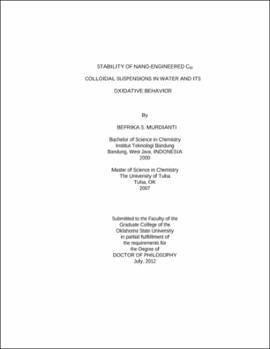| dc.contributor.advisor | Ausman, Kevin | |
| dc.contributor.author | Murdianti, Befrika S. | |
| dc.date.accessioned | 2013-11-26T08:21:28Z | |
| dc.date.available | 2013-11-26T08:21:28Z | |
| dc.date.issued | 2012-07 | |
| dc.identifier.uri | https://hdl.handle.net/11244/6464 | |
| dc.description.abstract | Scope and Method of Study: | |
| dc.description.abstract | Following the discovery of C60 in 1985, the compound has attracted much research due to its unique properties and wide array of potential applications from drug delivery to energy conversion. Multi-ton production of this compound began in 2003, and thus concerns of the fate of C60 in the environment began to be taken seriously. Although C60 has low solubility in water, it can form a stable aqueous colloidal suspension (termed nC60) through several methods, such as solvent exchange from organic solvents or long-term vigorous stirring in water. Literature reports have been seemingly contradictory about the stability, form, and environmental and health effects of this aqueous colloidal form. This study discuss the role of the [6,6]-closed epoxide derivative of C60 (C60O) in the formation and stabilization of the colloidal aggregates. Additionally, the oxidative behavior of nC60 as evaluated using the probe molecule dihydrorhodamine-123 (DHR 123) is also discussed. | |
| dc.description.abstract | Findings and Conclusions: | |
| dc.description.abstract | Stabilization of C60 colloidal particle in water is due to the formation of [6,6]- closed epoxide of C60. This derivative is present in small quantities due to the reaction with air. In the aqu/nC60 method, or the vigorous stirring of C60 solid in water, the presence of trace level of ozone in the ambient air is required for the formation of nC60 to produce sufficient C60O formation on the surface of nC60 particle to allow stable dispersion in water. Elimination of ambient air during the synthesis of aqu/nC60 significantly retards the formation of nC60 due to the inability to produce C60O. Eventhough other mechanism of stabilization of C60 in water such as hydroxylation of C60 has been proposed, this study strongly suggest that C60O plays an important role in stabilizing C60 colloidal suspensions in water. In the study of nC60 oxidative behavior using nC60 prepared using tetrahydrofuran and toluene, it has been shown that both preparation methods induce significant oxidation of the molecular probe DHR123. The formation of C60O during nC60 synthesis may give contribution to the observed oxidation. | |
| dc.format | application/pdf | |
| dc.language | en_US | |
| dc.rights | Copyright is held by the author who has granted the Oklahoma State University Library the non-exclusive right to share this material in its institutional repository. Contact Digital Library Services at lib-dls@okstate.edu or 405-744-9161 for the permission policy on the use, reproduction or distribution of this material. | |
| dc.title | Stability of nano-engineered C60 colloidal suspensions in water and its oxidative behavior | |
| dc.contributor.committeeMember | Blum, Frank | |
| dc.contributor.committeeMember | El Rassi, Ziad | |
| dc.contributor.committeeMember | White, Jeffery | |
| dc.contributor.committeeMember | Kalkan, Kaan | |
| osu.filename | Murdianti_okstate_0664D_12222.pdf | |
| osu.accesstype | Open Access | |
| dc.type.genre | Dissertation | |
| dc.type.material | Text | |
| dc.subject.keywords | aqueous fullerene colloidal suspension | |
| dc.subject.keywords | aqu/nc60 | |
| dc.subject.keywords | c60o | |
| dc.subject.keywords | c60 oxide | |
| dc.subject.keywords | nc60 | |
| thesis.degree.discipline | Physical Chemistry | |
| thesis.degree.grantor | Oklahoma State University | |
